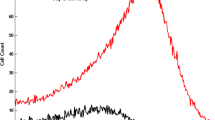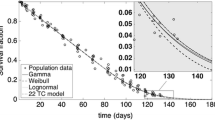Abstract
A new class of basic indirect pharmacodynamic models for agents that alter the loss of natural cells based on a lifespan concept are presented. The lifespan indirect response (LIDR) models assume that cells (R) are produced at a constant rate (k in ), survive during a certain duration T R , and finally are lost. The rate of cell loss is equal to the production rate but is delayed by T R . A therapeutic agent can increase or decrease the baseline cell lifespan to a new cell lifespan, T D , by temporally changing the proportion of cells belonging to the two modes of the lifespan distribution. Therefore, the change of lifespan at time t is described according to the Hill function, H(C(t)), with capacity (E max ) and sensitivity (EC 50), and the pharmacokinetic function C(t). A one-compartment cell model was examined through simulations to describe the role of pharmacokinetics, pharmacodynamics and cell properties for the cases where the drug increases (T D > T R ) or decreases (T D < T R ) the cell lifespan. The area under the effect curve (AUCE) and explicit solutions of LIDR models for large doses were derived. The applicability of the model was further illustrated using the effects of recombinant human erythropoietin (rHuEPO) on reticulocytes. The cases of both stimulation of the proliferation of bone marrow progenitor cells and the increase of reticulocyte lifespans were used to describe mean data from healthy subjects who received single subcutaneous doses of rHuEPO ranging from 20 to 160 kIU. rHuEPO is about 4.5-fold less potent in increasing reticulocyte survival than in stimulating the precursor production. A maximum increase of 4.1 days in the mean reticulocyte lifespan was estimated and the effect duration on the lifespan distribution was dose dependent. LIDR models share similar properties with basic indirect response models describing drug stimulation or inhibition of the response loss rate with the exception of the presence of a lag time and a dose independent peak time. The current concept can be applied to describe the pharmacodynamic effects of agents affecting survival of hematopoietic cell populations yielding realistic physiological parameters.
Similar content being viewed by others
References
Dayneka NL, Garg V, Jusko WJ (1993) Comparison of four basic models of indirect pharmacodynamic responses. J Pharmacokinet Biopharm 21: 457–478
Mager DE, Wyska E, Jusko WJ (2003) Diversity of mechanism-based pharmacodynamic models. Drug Metabol Disp 31: 510–519
Krzyzanski W, Ramakrishnan R, Jusko WJ (1993) Basic pharmacodynamic models for agents that alter production of natural cells. J Pharmacokinet Biopharm 21: 457–478
Ramakrishnan R, Cheung WK, Wacholtz MC, Minton N, Jusko WJ (2004) Pharmacokinetic and pharmacodynamic modeling of recombinant human erythropoietin after single and multiple doses in healthy volunteers. J Clin Pharmacol 44: 991–1002
Krzyzanski W, Jusko WJ, Wacholtz MC, Minton N, Cheung WK (2005) Pharmacokinetic and pharmacodynamic modeling of recombinant human erythropoietin after multiple subcutaneous doses in healthy subjects. Eur J Pharm Sci 26: 295–306
Samtani MN, Perez-Ruixo JJ, Brown K, Cerneus D, Molloy C (2007) Pharmacokinetic and pharmacodynamic model of pegylated thrombopoietin mimetic peptide in healthy subjects: comparison of verification procedures for assessing model predictability. In: Abstracts of the XVI annual meeting of the population approach group in Europe. Abstr. 1220 [www.page-meeting.org/?abstract=1220]
Lacombe C, Mayeux P (1998) Biology of erythropoietin. Haematologica 83: 724–732
Polenakovic M, Sikole A (1996) Is erythropoietin a survival factor for red blood cells?. J Am Soc Nephrol 7: 1178–1182
Trial J, Rice L, Alfrey CP (2001) Erythropoietin withdrawal alters interactions between young red blood cells, splenic endothelial cells, and macrophages: an in vitro model of neocytolysis. J Invest Med 49: 335–345
Al-Huniti NH, Widness JA, Schmidt RL, Veng-Pedersen P (2005) Pharmacodynamic analysis of changes in reticulocyte subtype distribution in phlebotomy-induced stress erythropoiesis. J Pharmacokinet Pharmacodyn 32: 359–376
Krzyzanski W, Perez-Ruixo JJ (2007) An assessment of recombinant human erythropoietin effect on reticulocyte production rate and lifespan distribution in healthy subjects. Pharm Res 24: 758–771
Harker LA, Roskos LK, Marzec UM, Carter RA, Cherry JK, Sundell B, Cheung EN, Terry D, Sheridan W (2000) Effects of megakaryocyte growth and development factor on platelet production, platelet life span, and platelet function in healthy human volunteers. Blood 95: 2514–2522
Roskos LK, Lum P, Lockbaum P, Schwab G, Yang B-B (2006) Pharmacokinetic/pharmacodynamic modeling of pegfilgrastim in healthy subjects. J Clin Pharmacol 46: 747–757
Krzyzanski W, Woo S, Jusko WJ (2006) Pharmacodynamic models for agents that alter production of natural cells with various distributions of lifespans. J Pharamacokinet Pharmacodyn 33: 125–166
Freise KJ, Widness JA, Schmidt RL, Veng-Pedersen P (2007) Pharmacodynamic analysis of time-variant cellular disposition: reticulocyte disposition changes in phlebotomized sheep. J Pharamacokinet Pharmacodyn 34: 519–547
D’Argenio DZ, Schumitzky A (1997) ADAPT II user’s guide. Biomedical Simulations Resource, Los Angeles
McKenzie SB (1996) Textbook of hematology. Williams & Wilkins, Baltimore, pp 101–102
Cheung WK, Goon BL, Guilfoyle MC, Wacholtz MC (1998) Pharmacokinetics and pharmacodynamics of recombinant human erythropoietin after single and multiple subcutaneous doses to healthy subjects. Clin Pharmacol Ther 64: 412–423
Major A, Bauer C, Breymanann C, Huch A, Huch R (1994) rh-Erythropoietin stimulates immature reticulocyte release in man. Br J Haematol 87: 605–608
Perez-Ruixo JJ, Kimko HC, Chow AT, Piotrovsky V, Krzyzanski W, Jusko WJ (2005) Population cell life span models for effects of drugs following indirect mechanisms of action. J Pharmacokinet Pharmacodyn 32: 767–793
Olsson-Gisleskog P, Jacqmin P, Perez-Ruixo JJ (2007) Population pharmacokinetics meta-analysis of recombinant human erythropoietin in healthy subjects. Clin Pharmacokinet 46: 159–173
Belair J, Mackey MC, Mahaffy JM (1995) Age-structured and two-delay models for erythropoiesis. Math Biosci 128: 317–346
Uehlinger DE, Gotch FA, Sheiner LB (1992) A pharmacodynamic model of erythropoietin therapy for uremic anemia. Clin Pharmacol Ther 51: 76–89
Krzyzanski W, Jusko WJ (2002) Multiple-pool cell lifespan model of hematologic effects of anticancer agents. J Pharmacokinet Pharmacodyn 29: 311–337
Ramakrishnan R, Cheung WK, Farrell F, Kelley M, Jolliffe L, Jusko WJ (2003) Pharmacokinetic and pharmacodynamic modeling of recombinant human erythropoietin after intravenous and subcutaneous single dose administrations in cynomolgus monkeys. J Pharmacol Exp Ther 306: 324–331
Woo S, Krzyzanski W, Jusko WJ (2006) Pharmacokientic and pharmacodynamic modeling of recombinant human erythropoietin after intravenous and subcutaneous administration in rats. J Pharmacol Exp Ther 319: 1297–1306
Holford NHG (2005) PK/PD models for red blood cell responses to erythropoietic stimulation with and without chemotherapy and iron supplements. In: Symposium annual meeting, Orlando, FL, USA. American Society for Clinical Pharmacology and Therapeutics
Gieschke P, Chanu P, Charoin J-E, Pannier A, Reigner B (2006) Modelling of haematological responses to erythropoiesis-stimulating agents in healthy volunteers and patients. In: Fifth international symposium on measurement and kinetics of in vivo drug effects, Noordwijkerhout, The Netherlands
Chapel SH, Veng-Pedersen P, Schmidt RL, Widness JA (2000) A pharmacodynamic analysis of erythropoietin-stimulated reticulocyte response in phlebotomized sheep. J Pharmacol Exp Ther 295: 346–351
Veng-Pedersen P, Chapel SH, Schmidt RL, Widness JA (2002) An integrated pharmacodynamic analysis of erythropoietin, reticulocyte, and hemoglobin responses in acute anemia. Pharm Res 19: 1630–1635
Friberg LE, Freijs A, Sandstrom M, Karlsson MO (2000) Semiphysiological model for the time course of leukocytes after varying schedules of 5-fluorouracil in rats. J Pharamcol Exp Ther 295: 734–740
Perez-Ruixo JJ, Krzyzanski W, Hing J (2008) Pharmacodynamic analysis of recombinant human erythropoietin effect on reticulocyte production rate and age distribution in healthy subjects. Clin Pharmacokinet 46: 399–415
Sharma A, Jusko WJ (1996) Characterization of four basic models of indirect pharmacodynamic responses. J Pharmacokinet Biopharm 24: 611–634
Krzyzanski W, Matsushima JN, Matsushima JN, Jusko WJ (2006) Assessment of dosing impact on intra-individual variability in estimation of parameters for basic indirect response models. J Pharmacokinet Pharamcodyn 33: 635–655
Wyska E, Mager DE, Krzyzanski W (2003) Methods of estimation IC50 and SC50 parameters for indirect response models from single dose data. J Pharm Sci 92: 1438–1454
Krzyzanski W, Jusko WJ (1997) Application of moment analysis to the sigmoid effect model for drug administered intravenously. Pharm Res 14: 949–952
Mandema JW (1995) Population pharmacokinetics and pharmacodynamics. In: Welling PG, Tse FLS (eds) Pharmacokinetics: regulatory, industrial academic perspectives. Marcel Dekker, New York, pp 411–450
Egan TD, Lemmens HJ, Fiset P, Hermann DJ, Muir KT, Stanski DR, Shafer SL (1993) The pharmacokinetics of the new short-acting opioid remifentanil (GI87084B) in healthy adult male volunteers. Anesthesiology 79: 881–892
Glader B (2004) Destruction of erythrocytes. In: Greer JP, Rodgers GM, Forster J, Paraskevans F, Lukens JN, Glader B (eds) Wintrobe’s clinical hematology. 11. Lippincot Williams and Wilkins, Philadelphia
Perez Ruixo JJ (2006) Optimizing the design of phase I studies of erythropoietin receptor agonist through mechanism-based PK/PD modeling and simulation. In: Abstracts of the annual meeting of the population approach group in Europe, p. 15, Abstr. 1024 [www.page-meeting.org/?abstract=1024]
Perez-Ruixo JJ, De Ridder F, Kimko H, Samtani M, Cox E, Mohanty S, Vermeulen A (2007) Simulation in clinical drug development. In: Bertau M, Mosekilde E, Westerhoff H (eds) Biosimulation in drug development. Wiley-VCH, Weinheim, pp 1–24
Author information
Authors and Affiliations
Corresponding author
Additional information
This study was supported by Johnson & Johnson Pharmaceutical Research & Development, A Division of Janssen Pharmaceutica, NV, Beerse, Belgium, and in part by the National Institute of General Medical Sciences, National Institutes of Health Grant GM 57980.
Rights and permissions
About this article
Cite this article
Krzyzanski, W., Perez-Ruixo, J.J. & Vermeulen, A. Basic pharmacodynamic models for agents that alter the lifespan distribution of natural cells. J Pharmacokinet Pharmacodyn 35, 349–377 (2008). https://doi.org/10.1007/s10928-008-9092-6
Received:
Accepted:
Published:
Issue Date:
DOI: https://doi.org/10.1007/s10928-008-9092-6




